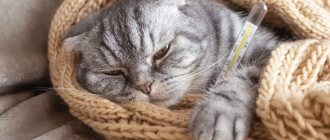An attentive person will immediately notice that a four-legged pet is sick or feels unwell, and will try to help his beloved cat. Before you panic and take your cat to the vet, we recommend taking his temperature. The result will show whether it is worth rushing to the veterinary clinic or whether you can take a wait-and-see approach.
The only reliable way to measure an animal’s thermometry is rectal.
Shown here is an insufficiently reliable method of measuring temperature under the armpit, which shows the temperature with an error.
Veterinarians consider other methods to be uninformative or unreliable.
What temperature is considered normal?
In an adult cat, this parameter should be in the range of 38-38.5°C. In a kitten, this figure is lower, and in newly born cubs, the body temperature ranges from 35.1 to 36.1 ° C. If necessary, the first measurement can be taken at one week of age.
Measuring a kitten's temperature
The following factors may affect temperature readings:
- age of the animal;
- individual characteristics (it is important to know what temperature is optimal for this particular cat);
- time of measurement (in the morning the readings are lower than in the evening);
- sleep state (temperature drops to 37°C);
- pregnancy (3-5 days before birth, body temperature drops by 1 degree);
- stress;
- binge eating;
- heatwave.
During the day, the parameters can change by 0.5 degrees.
If the thermometer shows less than 37.5 and above 40 degrees, but there are no symptoms of the disease, there is still a reason to urgently contact a veterinarian.
Note: If the kitten was born premature or very weak, its temperature may be so low that the cat will most likely lose interest in it and stop caring for it. In this case, it is necessary to create a warm microclimate in the place where the baby is.
It is noteworthy that the temperature of ordinary cats is almost the same as that of representatives of hairless breeds (for example, Sphynxes). But, since a body not covered with hair is noticeably warmer to the touch, many owners are mistaken about this point.
Sphinx
Why does a cat's body temperature change?
Normal indicators of the thermal state of a cat’s body are in the range of 38 – 39.5 degrees. In young animals, the limit is up to 39.3. Any deviations upward or downward are signs of an emerging disease.
| Normal in adults | Invalid values for adults | Normal for newborn kittens | Normal for kittens up to 7 months |
| 37.5 – 39°C | less than 37°C more than 40.5°C | 34.7 - 37.2°C | 36.5 - 37.0 °C 39 - 39.1 °C |
Data may fluctuate depending on the following factors:
- Physiology. During sleep, degrees drop due to reduced energy production. And, conversely, they increase during active games or after eating. Pregnant and lactating cats may have elevated levels.
- Age. In kittens up to 3-4 months of age, heat transfer is just beginning to develop. Therefore, the temperature deviates from the norm and is usually higher. In older cats, metabolic processes slow down, and indicators may be below normal. But this is not a pathology.
- Times of Day. It has been noted that in the evening the temperature of cats is slightly higher than in the morning.
- Stress. Sometimes in some animals the degrees rise to 39.5 during the measurement itself, as a reaction to stress.
Which thermometer is better to use?
It is optimal to use an electronic rectal thermometer to measure the body temperature of your furry pet. It produces reliable results in a few seconds and causes less inconvenience to the animal than all other possible options.
This thermometer is easy to use. In how to measure a cat's temperature with an electronic thermometer, the most difficult part is inserting the tip of the thermometer into the rectum. This must be done as carefully as possible so as not to cause pain to the animal or damage the intestines.
In what cases is measurement necessary?
There is a common belief that the main sign of fever in cats is a warm, dry nose. However, one should not rush to conclusions. This symptom may occur due to hot weather or appear during sleep.
This symptom is also observed in older pets - most often the cause is poor functioning of the glands responsible for moisturizing the surface of the nose. In this case, a cause for concern will be the presence of a number of other symptoms in addition to the indicated sign.
The following manifestations indicate changes in temperature indicators:
- the animal refuses to eat;
- the pet develops chills;
- the ears become hotter, the fur also heats up;
- the cat begins to avoid people;
- heartbeat and breathing become noticeably faster;
- activity decreases, behavior becomes passive;
- the animal vomits;
- there is dilation of the pupils;
- the mucous membrane and skin turn pale;
- discharge appears from the nose, eyes and ears;
- the pet is very thirsty.
Refusal to eat
How to detect a fever in a cat
You can suspect an increase or decrease in temperature based on a number of signs, which include:
- ears, nose and skin that are hot or too cold to the touch;
- chills, severe body tremors;
- refusal to eat, nausea, vomiting;
- changes in behavior, aggression or desire to hide in a dark corner;
- increased heart rate, increased breathing;
- strong thirst;
- dilated pupils;
Dilated pupils in a cat are one of the signs of a change in temperature in an animal
- lack of physical activity, lethargy and drowsiness;
- discharge from the nose, ears and eyes.
Many owners believe that the main sign of a febrile condition is a dry, hot nose, but veterinarians refute this opinion. A warm and dry surface of the nose occurs after sleep or active play, as well as in older individuals, who are characterized by a slowdown in metabolic processes.
A dry, hot cat's nose is not a cause for concern.
A sick cat will hide from people, hide in dark corners, lie motionless and refuse food - this is the way nature tells it to fight the disease. In addition, the pet may often close its eyes, which makes its third eyelid visible, which is normally invisible from the outside.
Lethargy and loss of appetite are a symptom of an increase or decrease in temperature
Important! A severe drop in temperature in cats is more dangerous than a fever - such conditions require immediate medical attention, so your pet should be taken to a veterinarian as soon as possible.
What to do when the temperature drops
Hypothermia, or low temperature, is considered a more dangerous condition than fever, so the cat should be taken to the clinic immediately or a veterinarian called to your home. A temperature of 36 degrees and below is considered a direct threat to the life of a pet - at such indicators it can fall into shock or coma. While waiting for medical help, you need to warm the animal - wrap it in a warm blanket, put it on a heating pad, and give it warm water or milk.
Cat in a veterinary hospital
If it was not possible to measure your pet’s temperature or the thermometer shows normal numbers, but the animal’s condition is cause for concern, it is recommended to show it to a veterinarian. When it comes to your pet's health, it is better to be vigilant than to ignore symptoms and leave a serious pathology untreated.
How can you help a cat with a high temperature?
How can you alleviate your pet’s condition until the doctor gives an antipyretic injection?
A towel for a compress for a cat, we reduce the temperature just like for people
If you have ice, wrap it in a cloth and apply it where the blood vessels are located - on the folds of the paws, in the neck area. If there is no ice, a cloth soaked in very cold water will do.
You can give ¼ tablet of analgin.
But if you notice the symptoms described above, do not immediately assume that your pet has a fever. Chills and lethargy may indicate otherwise. And a low temperature is no less dangerous for a cat. At 36 °C she may even go into shock .
An additional symptom is that when the temperature drops below normal, the cat’s mucous membranes usually turn pale. This reaction can also be caused by serious illnesses, including cancer. Although this could be a banal hypothermia of the body.
And again, a thermometer will help you. We measure the temperature, and if necessary, rush to the doctor .
It is somewhat easier to understand that the temperature has deviated from normal in “hairless” cats, such as Sphynx cats. Fluffy fur in animals is a kind of layer that will prevent you from suspecting the presence of fever using the simplest method - by touch.
How to measure with a mercury thermometer?
This is perhaps the most common and accessible way to determine an animal’s temperature. And yet it has significant disadvantages:
What not to do...
- During the procedure, the cat will behave restlessly , which is why the thermometer, which contains mercury, which is dangerous for both animals and humans, may break.
- The measurement time with such a thermometer is from 5 to 7 minutes , which is quite a long time for a pet (the cat may worry and resist).
If the thermometer breaks, under no circumstances should the mercury be touched with bare hands or a damp cloth. You can remove the substance using a copper plate. If some of the mercury or glass remains in the animal's anus, you should immediately consult a doctor.
Types of thermometers and their features
You can measure your pet's body temperature using special measuring devices - thermometers. There are various modifications and types of thermometry devices.
Based on the measurement principle, there are mercury, electronic and infrared thermometers. Depending on the method of measurement, there are universal, rectal and ear devices.
Until recently, the most common one was the mercury thermometer. The device is inconvenient because in order to measure the temperature correctly, the animal must be held for at least 5 minutes. If the device is in contact with the body for less time, the readings may be incorrect. When performing thermometry using a mercury device, it is necessary to securely fix the pet to avoid injury to the rectum.
The danger of such a measuring device lies in the toxicity of mercury vapor if its integrity is damaged. If there is no safer device in the house, you can measure the cat’s temperature with a mercury thermometer, being careful. Before being puzzled by the question of how to measure a cat’s temperature, the owner should know that there are modern thermometers based on the electronic principle
Such devices are characterized by accuracy and simplicity of the procedure. Electronic gadgets for measuring temperature can be of the following types:
Before being puzzled by the question of how to measure a cat’s temperature, the owner should know that there are modern thermometers based on the electronic principle. Such devices are characterized by accuracy and simplicity of the procedure. Electronic gadgets for measuring temperature can be of the following types:
| Types of electronic thermometers | a brief description of | Photo |
| Rectal | The device is inserted into the anus, then the button should be pressed. After approximately 60 seconds, a beep will sound indicating the completion of the measurement. The electronic rectal device is characterized by measurement accuracy. This thermometer has a high speed of parameter measurement, ease of use and safety. Some devices allow you to measure for 10 seconds. If the thermometer is damaged or dropped, unlike its mercury counterpart, the electronic device does not pose a danger to others. | |
| Universal | These electronic gadgets can be used not only rectally, but also measure the temperature in the cat’s armpit. However, it should be borne in mind that measurements with such a device should be carried out for at least 3 minutes. Only in this case the indicator will be correct. The device, as a rule, has a liquid crystal display that displays readings in hundredths of a degree. Some models of electronic devices are equipped with additional useful functions: storing the latest measurements, a timer, the ability to measure the temperature in the room, and automatic shutdown. All devices are safe and shock resistant. | |
| Infrared ear thermometers | The tip of this device is designed in such a way that it safely measures the temperature in the auricle. The advantage of a modern measuring device is its fast measurement speed (up to 30 seconds), ease of use and safety. Thermometry in the auricle does not cause the animal much concern. In addition to ear devices, there are non-contact infrared thermometers that allow you to determine the body temperature of an animal at some distance from it. |
How and with what to measure a cat's temperature
To determine that your pet has a fever, indirect signs such as lethargy and a dry nose are not enough. For this you will need a thermometer. It is recommended to use a veterinary ear thermometer - it is easy to use and will not cause any discomfort to the cat. Other options are a flexible electronic and infrared thermometer, they are also acceptable and convenient to use, but the measurement accuracy will not be as high. An ordinary mercury thermometer will provide the greatest accuracy, but you will need to measure the temperature rectally.
Usually this is not necessary, but sometimes you still have to resort to this method. The more calmly your pet behaves during the procedure, the more accurate the result will be. Therefore, it is necessary to swaddle him or ask someone to hold him. During the procedure, you should speak kindly to the cat so that it calms down.
Steps to take when measuring a cat's temperature rectally:
- Free the area around the anus from fur.
- Lubricate the tip of the thermometer and the insertion site with Vaseline or baby cream.
- Insert the thermometer approximately 2.5 cm using a gentle twisting motion.
- Hold it for at least 3 minutes, preferably 5.
If the cat doesn’t give in at all, and it’s not possible to measure the temperature exactly this way, then all that remains is to resort to a digital thermometer. The usual way for people is to hold the thermometer under their arm; it is not advisable to use it. The accuracy of the results will certainly make the best. However, if there are no other options, and the cat’s fur is not too long and thick, you can try.
If after measuring it turns out that your pet’s temperature is 38 or even 39 degrees, do not be alarmed, it is in this range that it is normal for cats. Moreover, in hairless breeds it can even reach 41 degrees, and at the same time remain within normal limits. Therefore, it is better to clarify what values are typical for the breed to which your cat belongs.
It is also important that kittens’ usual temperature is lower - about 36 degrees, and as they grow older it gradually increases. In older animals, metabolic processes are slowed down, and therefore it becomes slightly lower.
How to measure rectally?
The most accurate and reliable way to measure temperature parameters at home is to use a rectal thermometer. Due to the fact that the process is unpleasant for the animal and causes significant inconvenience, the measurement must be carried out very carefully, and it is best to entrust this matter to a person with experience.
Before taking your cat's temperature, it is recommended to trim its nails. To prevent the pet from resisting, it is better to wrap it in a blanket or hold it by the paws and head. In this case, at least two people will be needed to take the measurement. If the cat behaves calmly, just pet it, then you can begin the procedure. At this moment, the animal should lie on its side or stand. In the first case, the cat should not be allowed to tuck its tail and curl up into a ball.
- Not a thermometer, just not there...
Before starting the measurement, the thermometer must be disinfected, lubricated with a rich cream and carefully inserted into the anus with rotational movements to a depth of 2-3 cm. After the measurement is completed, the cat should be petted and treated with a treat, the thermometer must be treated with a disinfectant.
The accuracy of the readings is achieved by the fact that the sensor is located at the very tip of the thermometer. For the same reason, there is no need to run the device deep. The small size of the thermometer eliminates unnecessary inconvenience, thereby simplifying the measuring process. In addition, the device is equipped with a sensor that signals the end of the procedure.
Preparing for measurement
The following types of thermometers are used to measure cat body thermometry:
- rectal;
- electronic digital;
- mercury;
- infrared (laser).
In practice, veterinarians use household mercury and special veterinary thermometers.
For reasons of hygiene, it is better to keep a separate thermometer for your pet in your first aid kit.
Before measuring rectal temperature, it is recommended to wear disposable rubber gloves, disinfect the thermometer and lubricate the tip with Vaseline or greasy cream.
Flea remedies for cats and kittens
How to adopt a kitten from a shelter
How to get rid of cat urine smell forever
Measurement methods
You can carry out thermometry on an animal at home either independently or with the support of an assistant. It is best to place your pet on a non-slip, flat surface, turning it sideways. If the manipulation is carried out with an assistant, then he can hold the cat in this position by the withers.
The animal's tail must be raised and moved to the side.
When taking thermometry with an electronic device, press a button before insertion. In this case, the measurement time will be automatic - until the sound signal of the end of the measurement. The mercury thermometer must be shaken before use.
The device should be inserted parallel to the animal's spine, trying not to tilt the tip to the sides. Correct insertion of the measuring device, as a rule, does not cause resistance in the pet. However, overly nervous cats may perceive this procedure negatively.
If a mercury thermometer is used, it is necessary to ensure that the animal remains motionless for 5 minutes. Particularly obstinate individuals should be wrapped in a towel, securely securing the back of the body
It is important to maintain the necessary time for measurement to avoid obtaining incorrect results.
After a sound signal from the electronic device or after the measurement time with a mercury thermometer has expired, the device is carefully removed from the animal’s rectum. After the readings are recorded, the thermometer is disinfected with alcohol
The manipulation should be carried out with gloves. The calm state of the owner and the absence of fuss in movements are emotionally transmitted to the pet, which simplifies thermometry.
It is not always easy to measure the temperature of a pet, since cats do not tolerate such manipulations well. It is recommended to follow the tips to make the task easier. You need to be patient and also ask for help from another person, since it is difficult to cope with the task on your own. You definitely need to know how to properly measure a cat's temperature.
Procedure:
- First you need to calm your pet. It is advisable to choose a moment when he is sleeping or in a calm state. In this case, it will be easier to calm your pet and achieve what you want. During the entire process, you will have to caress and talk to the animal to make it feel more comfortable.
- You need to choose a suitable place. It is advisable to carry out the procedure on a table to make it easier to hold the cat. You can wrap it in a blanket, leaving access to the anus. Otherwise, another person will have to hold the animal by the paws, placing the patient on his side. If you use a thermometer for the auricle, then you will have to fix your head and make sure that there is no movement.
- The thermometer should always be disinfected. To do this, you can use alcohol or a solution of chlorhexidine. You need to soak cotton wool in the product and then wipe the tip. You will need to rub it dry and then lubricate it with Vaseline. In this case, it will be much easier to use a thermometer.
- The measurement process itself is as follows. The cat needs to raise its tail and then place the tip about 2 cm into the anus. You will need to calm the animal for the required time and make sure that it does not move. All that remains is to take out the device and look at the value to confirm or refute hyperthermia.
- You will need to clean the device after the procedure. It is washed with soap and wiped with alcohol to remove dirt.
- rectal thermometer - an electronic device that responds instantly and shows accurate results;
- electronic thermometer - often used as the main device for determining the temperature of pets;
- mercury thermometer - used in extreme cases and gives readings after 5 minutes.
According to experts, it is recommended to refrain from measuring temperature non-rectally. Sometimes you can do without a thermometer and use other available methods that will be simpler but less accurate.
If you don’t have the necessary device at hand or your pet resists quite strongly, then you can measure the temperature without a thermometer.
Chills and trembling in the body at normal room temperatures may indicate signs of ill health in your pet. Elevated temperatures are indicated by the cat’s inappropriate behavior, taking a stiff posture, and refusing to drink or eat.
Source
Rectal temperature measurement
How to measure a cat's temperature rectally? This is the most reliable way to measure your pet's body temperature.
The thermometer is thoroughly washed with soap and water, then generously lubricated with Vaseline or greasy cream. Then the device is inserted into the animal’s rectum with slow, careful rotational movements no deeper than 1 cm. An important condition: the thermometer must be slightly tilted so that its tip touches the walls of the rectum.
Rectal method of measuring temperature
When measuring the temperature, it is best to talk to the animal calmly and also avoid sudden movements that could injure it.
The advantages of the procedure are the ability to find out the exact indicator, no need to spend a lot of time on the procedure.
Disadvantages - this procedure is very unpleasant and painful for the animal, so the owner is required to carefully prepare for the procedure and take into account all its nuances.
Before measuring the temperature in this way, it is advisable to trim the animal’s claws and also secure it well. If possible, it should stand or lie on its side. It is also desirable that two people participate in this and be able to hold the cat by the paws, scruff and head. It is very undesirable for a cat to curl up in a ball or press its tail to its body.
After the owner has managed to measure the cat’s temperature, the thermometer must be wiped with alcohol and thoroughly disinfected, and the animal must be petted and tasty fed as encouragement.
If, when removing the thermometer, there are remains of black tarry feces or blood on it, you should immediately contact a veterinarian. These symptoms may indicate serious complications of the disease.
Important! After disinfecting the thermometer, it is also important to thoroughly rinse the sink so as not to spread the infection throughout the apartment.
Causes of high/low temperature
If, after measuring your temperature, you notice that the readings are below normal, then this may indicate:
- stress or shock;
- consequences of anesthesia;
- hypothermia;
- injury;
- the presence of cardiovascular or nervous disease.
Indicators above the normal limit indicate
:
- a possible reaction to taking the medicine (often this possibility is described in the side effects of the medicine or your doctor should warn you about it);
- poisoning;
- oncology;
- infectious disease;
- metabolic disease;
- endocrine disease.
If the temperature rises/falls briefly and returns to normal within 10-12 hours, then there is no need to panic; this may be a consequence of stress or overexertion of the cat. It is advisable to monitor the dynamics of temperature changes every hour or two. But if the temperature persists throughout the whole day and does not drop at all, then you should immediately consult a doctor. The veterinary clinic will conduct the necessary tests, determine the root cause of the elevated temperature, and then prescribe a course of treatment. You should never leave treatment to chance; such an attitude can lead to disastrous results.
Measuring the kitten's temperature is especially important, because... if its body temperature is low, the cat may abandon the kitten. She will give him milk, but will stop licking the kitten, thereby not stimulating normal bowel function. To avoid this, the kitten needs proper care; it needs to be constantly in a warm room.
If your cat has a high fever and there is no way to go to the veterinary clinic, then you can give her a crushed analgin tablet dissolved in milk. For a kitten, half or even a quarter of a regular tablet will be enough. You also need to remember about drinking, constantly give your cat milk. When you decide to go on a trip and the temperature is 40 0 C or higher, you need to wrap the cat in a damp towel or take ice with you.
A high temperature in most cases indicates the presence of an infection.
And it’s better not to call a doctor at home, but to go straight to the clinic for tests.
Don't be afraid to measure your cat's temperature if you notice signs of an increase/decrease in it. Remember that your pet’s health depends only on you and your attention.
Vet
A domestic cat that appears lifeless and gloomy may be suffering from a fever. If such suspicions arise, you need to check your pet's temperature at home.
Some tips for checking temperature without a meter
- Feel your pet's ears. If the ears are hot, this is a symptom of fever.
- Stroke the cat's belly. If your cat has a fever, this area will also be hotter than usual. Of course, make sure that your pet has not previously basked in the sun or near a heater/radiator.
- High temperature often leads to dehydration of the body. Squeeze the skin at the nape of the neck and release. If the skin remains wrinkled, your cat may be dehydrated. Accordingly, there is a high probability that the temperature is above normal.
Increased temperature readings may also be indicated by:
- runny nose and frequent sneezing;
- rapid heartbeat or arrhythmia;
- wheezing and shortness of breath;
- lethargy, weakness, “silk” state;
- lacrimation and souring of the eyes;
- tousled and dull coat;
- lack (decreased) appetite;
- yellowish or pale throat.
How to determine temperature without a thermometer
- On the nose. This is, let’s say, a litmus test for the health status of any animal. If the cat is completely healthy, then his nose will be cool and slightly moist. A dry and hot surface of the nose should alert the owner. This is a sure signal that something is wrong with your pet, perhaps the temperature has risen. They focus on the condition of the nose only if the pet is awake, but not carried away by any active activity. During sleep, cats' noses are dry, and after active play, they become hot.
- According to general condition. If, at normal air temperatures, the cat is cold and trembling, this is a signal that the animal’s body temperature has most likely risen above normal.
- By behavior. When the temperature is high, the pet demonstrates inappropriate behavior: it hides from prying eyes, takes an unnatural position, does not lie down, and refuses food and water.
- In a healthy animal that is awake, the third eyelid is not visible. It hides the eyelid when the cat sleeps. With hyperthermia, a vertical fold of the mucous membrane of the eye becomes noticeable.
Let’s immediately figure out how to determine a pet’s temperature without error. Traditionally, a mercury thermometer is used to measure baseline temperature, which is inserted into the anus.
To reduce discomfort, before inserting into the anus, the tip of the thermometer must be warmed in your hands and thoroughly lubricated with Vaseline. It is advisable for the cat to lie on its side, although some animals tolerate the procedure easier in a standing position.
As you know, a measurement with a mercury thermometer is considered accurate if it was carried out for 7–10 minutes. Be careful to hold the thermometer firmly as the cat may relax and tense, causing it to move in the rectum.
During the entire period of temperature measurement, the pet must be held firmly, since careless movements and sudden movements can lead to damage to the thermometer and injury.
Modern technology offers several methods of measuring temperature with less discomfort for your pet. Clinics often use thermometers that quickly record the temperature using a measurement in the auricle. The device is specific, veterinary and not cheap.
Many owners have adapted to measuring the temperature of their pets using children's, non-contact thermometers.
The operating algorithm of the device is simple: an infrared beam is directed to the area of the body whose temperature needs to be measured. As you know, the difference in temperature between the skin and internal organs can be 2–3 degrees.
Determining body temperature without a thermometer is always fraught with error. Note that tactile temperature determination does not provide enough data to suspect a lethargic state or fever in a cat. A critical decrease and increase in temperature are considered equally dangerous conditions.
On the cat's nose
Many owners believe that body temperature is determined by the nose. The cliché says: “a cold and wet nose means there is no temperature, a hot and dry nose means there is a temperature.”
- In fact, a cool, wet nose is normal when your cat is active.
- If your pet has slept in a warm place for a long time, a dry and warm nose will be considered normal.
- During a fever, your cat may have a hot and runny nose, which may indicate the development of a viral or infectious disease.
By the ears
The next reference point by which it is customary to determine temperature is the ears. The diagnostic method cannot be called accurate, but the data obtained by it is clearly closer to the truth than “nasal diagnosis”.
A cat's ears are covered with thin, sensitive skin without a layer of fat. Blood vessels lie directly under the skin, so tactile sensations provide fairly accurate data on body temperature.
Along the armpits
The armpits and peritoneal area, provided there is no large amount of fur, also serve as indicators for determining temperature.
- To properly feel your body temperature, your hands need to be warm.
- The palms are placed on an open area of the body and held for several seconds.
- If your skin quickly adapts to body temperature, the temperature is most likely normal.
By mucous membranes
Mucous membranes are one of the most accurate landmarks for determining body temperature without a thermometer.
- At elevated temperatures, a cat's gums are hot to the touch, and their pigmentation becomes more intense (pink or even red).
- At low temperatures, the color of the gums fades to whitish, bluish, yellowish or gray (discolored). At the same time, the gums seem cold to the touch.
Normal cat temperature
Cats are warm-blooded animals, whose normal body temperature ranges from 37.5 °C to 39 °C. The exact numbers are individual for each cat. And it is very important for owners to know them, since this will determine which values should be considered reduced and which should be considered increased.
Temperature is an important indicator of an animal's health
So, for example, 39.2 °C will be considered a slight increase for a pet with a normal temperature of 38.9 °C, but for an animal with a daily temperature of 37.5 °C it will be an alarming symptom. A mark of less than 37 °C and above 40 °C, regardless of the individual norm, will be a cause for concern for the owner.
Note! During the day, temperature readings can change by approximately half a degree. During sleep and in the morning the values are somewhat lower, while in the evening after active pastime or eating they increase.
For kittens, other temperature values are considered the norm, since the mechanism of thermoregulation of small fluffies is formed gradually. In newborns they vary in the range of 35.5-36.5 °C, increasing over time to 38.5-39.5 °C, and after reaching four months of age they become like those of adults.
The thermal state of kittens differs from the temperature of adult cats
In aged cats, metabolic processes in the body slow down, and therefore the temperature decreases. In pregnant cats, on the contrary, it increases, which is the norm.
The temperature may also increase in the first days after sterilization of the animal. This is how the cat’s body reacts to the trauma it has suffered. You should contact a veterinarian if it persists for more than 5 days after surgery; most likely, the animal is developing a pathological inflammatory process.











